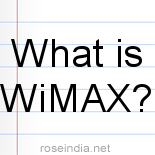What is WiMAX?
IntroductionWhat is WiMAX? Simply put WiMAX is, Worldwide Interoperability for Microwave Access, a technology standard that enables high speed wireless internet. In other words, WiMAX combines the high speed of a broadband connection with the convenience of mobile internet connectivity. WiMAX provides wireless broadband access up to a radius of 50 kilometers (30 miles) for fixed receivers and 5-15 kilometers (3-10 miles) for mobile receivers.
How does WiMAX work?WiMAX needs setting up of a tower to establish microwave connections with the users. This operates in the same way as a cell phone tower. In the case of WiMAX, the tower is connected to internet through a high speed cable like a T3 line. The difference from broadband is that here the bandwidth does not have to be divided using wires.
WiMAX is in a way an advanced version of WiFi, a similar technology. Whereas WiFi allows a network within a radius of 30-100 meters (100-300 feet), WiMAX connectivity can be extended over a radius of up to 50 kilometers. This high speed data transfer over a much larger area is made possible by lessening interference using the IEEE 802.16 Air Interface Standard. Currently WiMAX operates on both licensed and non-licensed frequencies.
Advantage and ApplicationsAs it is possible to use WiMAX over longer distances, this technology may come in handy in creating city wide networks. It is also better suited than WiFi for large area public places like airports, college and university campuses and large office set ups. It also provides for greater mobility to users. This way WiMAX may be a good option for people on the move using gadgets like laptops, iPods and PDAs.
As WiMAX follows a point-to-multipoint architecture, it is an ideal solution for delivering broadband to places where it would not be viable to establish wired connections. Rural areas and high rises are examples for this situation. Currently this last mile part of the connectivity is the biggest stumbling block to broadband providers, in terms of cost and manpower requirements. WiMAX can bring down the costs and subsequently make internet connectivity cheaper to the end user.
Another advantage over some other wireless technologies is that WiMAX does not need a direct line of sight between the source and the receptor. It also has a comparatively high shared data rate at 70Mbps, which is good enough to reach about a thousand homes.
WiMAX is also an excellent saver of time. As it does not need cables to connect with the receptors, it is possible to establish connection to an entire campus or even city in a matter of a few days.
WiMAX also allows for greater convergence of diverse applications such as fixed and mobile telephony, apart from entertainment sectors like television. Challenges
That said, WiMAX need not come to eliminate wired connectivity altogether. In areas where wired broadband is already established, DSL still reigns supreme. Thus it is more likely that WiMAX will develop as a complementary to wired connectivity.
Secondly, the real potential of WiMAX is in the possibility of bringing diverse services such as telephony, mobile television and broadband internet under its umbrella. This requires that players from these different fields work together to provide single point service to the end user. Consumer billing and mutual settlement systems have to be extremely efficient to handle these requirements.



